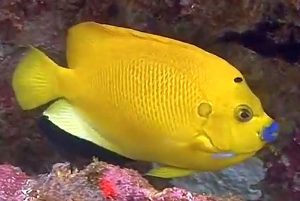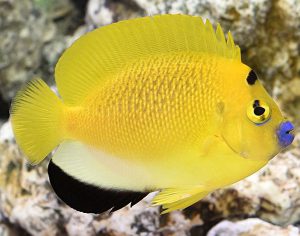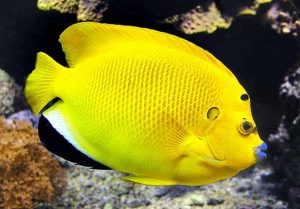The Flagfin Angelfish (Apolemichthys trimaculatus) known to tropical fish keeping enthusiasts as the Threespot Angelfish is widely distributed throughout Indo-West Pacific waters and ranges from East Africa south to the 28° parallel, east to Samoa, north to southern Japan, and south to the northern coasts and islands of Australia.
Juvenile Flagfin Angelfish are very secretive and are usually encountered alone near sponges and corals in the lagoons and seaward reef slopes of their range, at depths from 9 to over 190 feet. Although juveniles are usually found below 80 feet around the protection of rocky crevices and caves; adults are normally encountered at more moderate depths swimming alone, in mated pairs, or in small, loose groups feeding on sponges, algae, and tunicates.
Flagfin Angelfish have a bright yellow body color with blue lips, a dark blueish black dorsal spot on the forehead above the eye, and a lighter tan spot behind the eye above the gill covers. The dorsal, caudal, and pectoral fins are yellow. The anal fin is white with a wide black stripe along the outer half that resamples a flag, which gives them their common name. Males tend to be larger than females.
Juvenile Flagfin Angelfish lack the spots about the head, have a narrow black band through eye, and a series of golden bars on their side.
Because of their specialized diet and timid behavior, Flagfin Angelfish are difficult to keep an aquarium environment. Although they are most successfully housed in a mature reef aquarium of at least 125 gallon capacity with a crushed coral or sand substrate and plenty of live rock for them to hide among; they feed on sponges and are prone to nip at soft and stony corals as well as decorative clam mantles.
Flagfin Angelfish can be housed in an aged FOWLR aquarium as the only angelfish in the tank provided they have plenty of live rock to graze on and hide among. They are shy, timid, and easily stressed but do well with peaceful reef species like clownfish, gobies, damsels, etc. as tankmates. Although tropical fish keeping enthusiasts have reported keeping juvenile Flagfin Angelfish with Regal Angelfish, Moorish Idols, and several dwarf angelfish species; no long term success has been achieved.
The Flagfin Angelfish has successfully spawned in large public aquariums, however, they have never been bred in a home aquarium environment. `
Threespot Angelfish are broadcast spawners. In the wild, spawning normally begins at sunset with the actual courtship ritual occurring at dusk. Each male will swim toward and above their female and flutter their bodies in short jittery motions until the female is ready to spawn. When ready, the females will extend her fins and rise to the surface with the male moving below her belly to nuzzle it with his nose. As the pairs quiver and in their ascent toward the surface, they simultaneously release white clouds of sperm filled gametes into the water column for external fertilization.
The planktonic eggs drift with the current in the water column until they hatch into tiny larvae. After hatching, the finless fry live off their yolk sack until it is completely absorbed, at which point they drift down to the bottom of the reef and begin to eat small zooplankton.
In their natural habitat, Flagfin Angelfish consume vast quantities of sponge material, sea squirts, marine algae, and tunicates. In an aquarium environment, it is extremely important to replicate their diet to maintain proper nutrition and a healthy immune system.
They should be fed a high quality frozen angelfish preparation that includes a large amount of sponge material, a plethora of plant materials, and vitamin enriched meaty foods. A varied diet of spirulina algae, vitamin enriched brine shrimp, Mysis shrimp, seaweed (Nori) on a feeder clip, live sponges, frozen herbivore preparations, along with the live rock in the tank should provide them with their nutritional requirements. Feed them small portions at least three times a day.
Because of its specialized dietary requirement of sponges, its inability to readily adapt to other foods, and its propensity to acquire white spot disease, velvet, viral infections, and monogenetic flukes; Apolemichthys trimaculatus are recommended for expert aquarists only.
Although Flagfin Angelfish (Apolemichthys trimaculatus) are not considered RARE, they are not readily available to tropical fish keeping enthusiasts. When they arrive in fish shops in relatively good health, they are often kept in sterile quarantine settings without live rock. Being finicky eaters, they will often reject frozen or prepared foods that could preserve their health.
This being said, they are available from specialty fish shops and online wholesalers, retailers, and collectors at the following approximate purchase sizes: Small: 2″ to 2-3/4″; Small/Medium: 2-3/4″ to 3-1/4″; Medium: 3-1/4″ to 4″; Medium/Large: 4″ to 5″; Large: 5″ to 7″; XLarge: 7″ and larger; Depending on size and area of collection, they range in price from $109.99 for a small specimens to over $159.99 for 6″ individuals.
Minimum Tank Size: 125 gallons
Aquarium Type: Reef or FOLR
Care Level: Difficult
Temperament: Peaceful, except with other large Angelfish
Hardiness: Finicky eaters, Hardy when fully acclimated
Water Conditions: 72-78° F, dKH 8-12, pH 8.1-8.4, sg 1.020-1.025
Max. Size: 10.2″
Color Form: Black, Blue, Yellow
Diet: Omnivore
Compatibility: Reef with Caution
Origin: Indo-West Pacific
Family: Pomacanthidae
Lifespan: Over 7 years
Aquarist Experience Level: Expert Only




